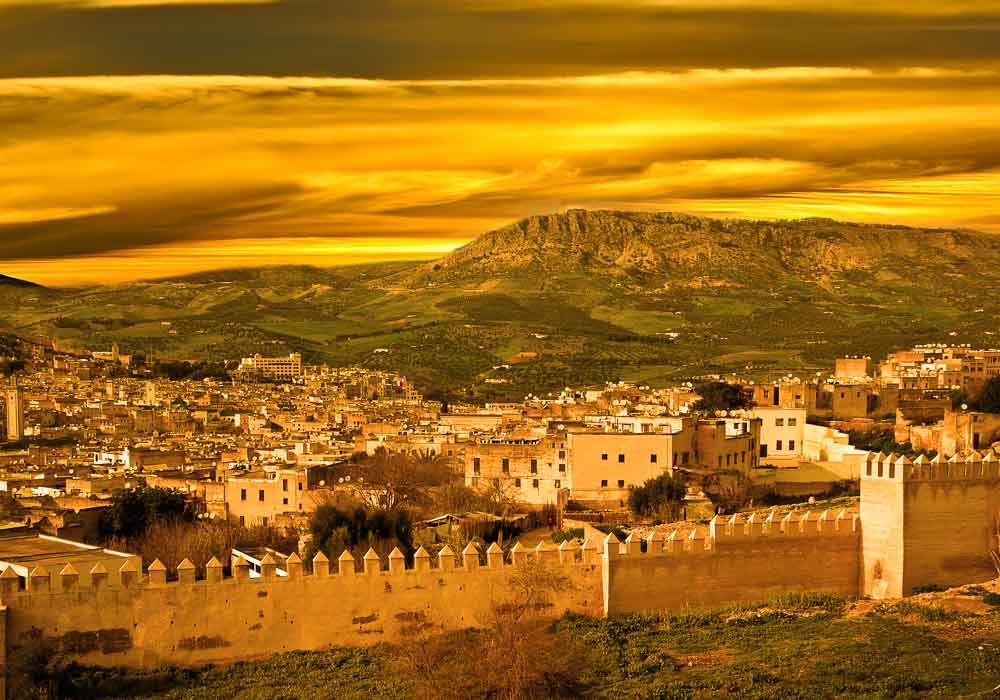Fez or Fes (Arabic: فاس faːs, Berber: ⴼⴰⵙ faːs, French: Fès) is the oldest and grandest of Morocco’s imperial cities. It is the second largest city in Morocco after Casablanca, with a population of 1.4 million (2014). Located to the northeast of Atlas Mountains, Fez is situated at the crossroad of the important cities of all regions; 206 km (128 mi) from Tangier to the northwest, 246 km (153 mi) from Casablanca, 169 km (105 mi) from Rabat to the west, and 387 km (240 mi) from Marrakesh to the southwest which leads to the Trans-Saharan trade route. Although Fez is no longer the nation’s political capital, it nevertheless remains its intellectual and spiritual center. Fez’s medina (walled medieval quarter) is an eye-popping labyrinth of winding streets crowded with madrasas (religious colleges), mosques, riads (courtyard houses), souks (markets), and artisan workshops.
Fez was founded under the Idrisid rule during the 8th-9th century and is three cities merged into one. Within the medina walls are Fez el Bali, the city’s birthplace in 789 and home to its most venerable monuments, and Fez Jdid, the 13th-century New Fez, site of the royal palace and the old Jewish quarter. Southwest of the medina is Ville Nouvelle, the French-built modern town. Marrakesh has long been Morocco’s “it” destination, but with the ongoing restoration of Fes el Bali, a newly energized dining scene, and a spate of stylish riad hotels, Fez is giving its rival to the south a run for its money.

Chronology of Events
789 – The city was founded on a bank of the Jawhar river by Idris I, founder of the Idrisid dynasty.
808 – Idris I’s son, Idris II, built a settlement on the opposing river bank which was later develop into two walled and largely autonomous sites and often in conflict with one another: Madinat Fas and Al-‘Aliya. In 808 Al-‘Aliya replaced Walili as the capital of the Idrisids.
9th century – Emigres from Andalusia (in 817-818) and Qaraouiyine, Tunisia (in 825), bring to Fez knowledge and skills that will make it a religious and cultural center. Upon the death of Idris II in 828, the dynasty’s territory was divided among his sons. The eldest, Muhammad, received Fez. The newly fragmented Idrisid power would never again be reunified. Al Qaraouiyine mosque and university are founded in 857 and 859 during Yahya ibn Muhammad’s rule in Fez.
10th century – The city was contested by the Caliphate of Córdoba and the Fatimid Caliphate of Tunisia, who ruled the city through a host of Zenata clients. The Fatimids took the city in 927 and expelled the Idrissids, after which their Miknasa were installed there. The Miknasa were driven out of Fez in 980 by the Maghrawa, their fellow Zenata, allies of the Caliphate of Córdoba. It was in this period that the great Andalusian ruler Almanzor commissioned the Maghrawa to rebuild and refurnish the Al-Kairouan mosque, giving it much of its current appearance.
11th-12th century – In 1033, several thousand Jews were killed in the Fez Massacre. The Berber Almoravid leader Yusuf ibn Tash/in conquers Fez in 1069. Madinat Fas and Al-‘Aliya were united in 1070 by the Almoravid dynasty: The walls dividing them were destroyed, bridges connecting them were built, and connecting walls were constructed that unified the medinas. Under Almoravid patronage the largest expansion and renovation of the Great Mosque of Kairouan took place (1134-1143). Almoravid impact on the city’s structure was such that the second Almoravid ruler, Yusuf ibn Tashfin, is often considered to be the second founder of Fez.
13th-15th century – The Marinid dynasty’s conquest of Fez in 1248 is the start of a golden age for the city. It regains capital status, and in 1276 a new town, Fez Jdid, is added to it which they made their administrative and military centre. Between 1271 and 1357 seven madrassas were built in Fez, the style of which has come to be typical of Fassi architecture. The Mellah, or Jewish quarter, is founded in 1438. The last Maranid sultan was overthrown during the 1465 Moroccan revolt. In 1474 the Marinids were replaced by their relatives of the Wattasid dynasty, who faithfully continued Marinid policies.
16th-17th century – The Saadian dynasty consolidates its hold over all of Morocco in 1554 with Marrakesh as the capital. Moulay al-Rashid, of the Alawite dynasty still ruling today, proclaims himself sultan in 1666 in Fez, the capital once more.
1790-1850 – The city became independent in 1790, under the leadership of Yazid (1790–1792) and later of Abu´r-Rabi Sulayman. In 1795 control of the city returned to Morocco. Fez took part in a rebellion in 1819-1821, led by Ibrahim ibn Yazid, as well as in the 1832 rebellion led by Muhammad ibn Tayyib.
1910’s – There is abdication of Abd al-Hafid, Sultan of Morocco in 1912. Under the 1912 Treaty of Fez, Morocco becomes a French protectorate and the capital is moved definitively to Rabat and remained there even after Morocco achieved independence in 1955. Fez’s European-style Ville Nouvelle is founded in 1916.
1980’s – Despite its traditional character, today Fez is a bustling commercial center. The popularity of the city has increased since present ruler, King Mohammed VI of Morocco, married a woman from Fez, Salma Bennani. In 1981 Fez’s medina is named a UNESCO World Heritage site.

Today – Place Lalla Yeddouna at the heart of the Medina is undergoing a construction which encompasses historic preservation of particular buildings, construction of new buildings that fit into the existing urban fabric and regeneration of the riverfront. The intention is to not only preserve the quality and characteristics of the UNESCO World Heritage Site, but also to encourage the development of the area as a sustainable, mixed-use area for artisanal industries and local residents.
